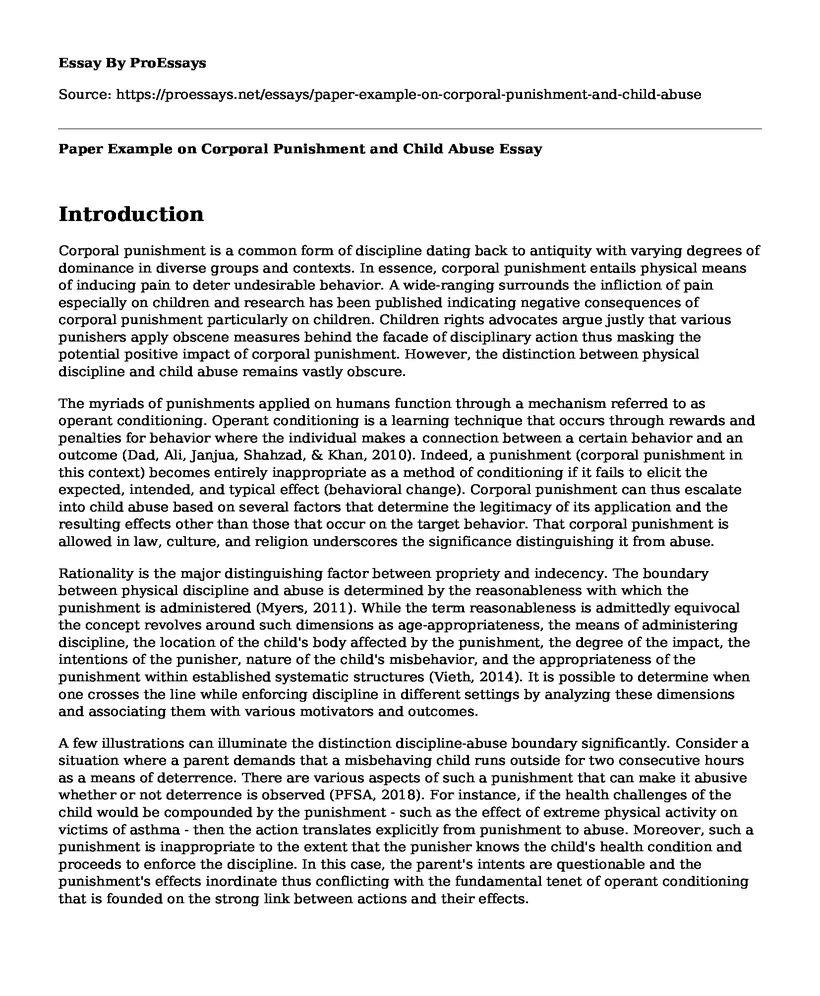Introduction
Corporal punishment is a common form of discipline dating back to antiquity with varying degrees of dominance in diverse groups and contexts. In essence, corporal punishment entails physical means of inducing pain to deter undesirable behavior. A wide-ranging surrounds the infliction of pain especially on children and research has been published indicating negative consequences of corporal punishment particularly on children. Children rights advocates argue justly that various punishers apply obscene measures behind the facade of disciplinary action thus masking the potential positive impact of corporal punishment. However, the distinction between physical discipline and child abuse remains vastly obscure.
The myriads of punishments applied on humans function through a mechanism referred to as operant conditioning. Operant conditioning is a learning technique that occurs through rewards and penalties for behavior where the individual makes a connection between a certain behavior and an outcome (Dad, Ali, Janjua, Shahzad, & Khan, 2010). Indeed, a punishment (corporal punishment in this context) becomes entirely inappropriate as a method of conditioning if it fails to elicit the expected, intended, and typical effect (behavioral change). Corporal punishment can thus escalate into child abuse based on several factors that determine the legitimacy of its application and the resulting effects other than those that occur on the target behavior. That corporal punishment is allowed in law, culture, and religion underscores the significance distinguishing it from abuse.
Rationality is the major distinguishing factor between propriety and indecency. The boundary between physical discipline and abuse is determined by the reasonableness with which the punishment is administered (Myers, 2011). While the term reasonableness is admittedly equivocal the concept revolves around such dimensions as age-appropriateness, the means of administering discipline, the location of the child's body affected by the punishment, the degree of the impact, the intentions of the punisher, nature of the child's misbehavior, and the appropriateness of the punishment within established systematic structures (Vieth, 2014). It is possible to determine when one crosses the line while enforcing discipline in different settings by analyzing these dimensions and associating them with various motivators and outcomes.
A few illustrations can illuminate the distinction discipline-abuse boundary significantly. Consider a situation where a parent demands that a misbehaving child runs outside for two consecutive hours as a means of deterrence. There are various aspects of such a punishment that can make it abusive whether or not deterrence is observed (PFSA, 2018). For instance, if the health challenges of the child would be compounded by the punishment - such as the effect of extreme physical activity on victims of asthma - then the action translates explicitly from punishment to abuse. Moreover, such a punishment is inappropriate to the extent that the punisher knows the child's health condition and proceeds to enforce the discipline. In this case, the parent's intents are questionable and the punishment's effects inordinate thus conflicting with the fundamental tenet of operant conditioning that is founded on the strong link between actions and their effects.
Conclusion
Besides intentions and effects on health, the propriety of punishments can be affected by factors including age and culture. A punishment can be classified as abusive if it conflicts with the beliefs and practices of larger systematic structures such as law, culture, and religion (Bornstein, 2012; Cuddy & Reeves, 2014). For example, certain cultures demand that children of distinct age brackets are disciplined depending on their gender where boys and girls are disciplined exclusively by elder people of their corresponding gender. Violating such practices can lead to abuse since the discipline casts doubts on the punisher's intentions. PFSA also advises punishers should only administer justice after cooling down their anger to limit the amount of force that they use while administering discipline. Overall, the lack of reasonableness during the enforcement of discipline erodes the distinction between corporal punishment and child abuse.
References
Bornstein, M. H. (2012). Cultural approaches to parenting. Parenting, Science and Practice, 12(2-3), 212-221.
Cuddy, E. & Reeves, R. V. (2014, November 6). Hitting kids: American parenting and physical punishment. Brookings. Retrieved from https://www.brookings.edu/research/hitting-kids-american-parenting-and-physical-punishment/
Dad, H., Ali, R., Janjua, M. Z., Shahzad, S. & Khan, M. S. (2010). Comparison of the frequency and effectiveness of positive and negative reinforcement practices in schools. Contemporary Issues in Education Research, 3(1), 127-236.
Myers, J. E. B. (2011). Myers on evidence of interpersonal violence: Child maltreatment, intimate partner violence, rape, stalking, and elder abuses. New York, NY: Aspen Publishers.
PFSA. (2018). Discipline, parenting styles and abuse. Harrisburg, PA: Pennsylvania Family Support Alliance.
Vieth, V. I. (2014) "From sticks to flowers: Guidelines for child protection professionals working with parents using scripture to justify corporal punishment," William Mitchell Law Review, 40(3), 908-942.
Cite this page
Paper Example on Corporal Punishment and Child Abuse. (2022, Aug 15). Retrieved from https://proessays.net/essays/paper-example-on-corporal-punishment-and-child-abuse
If you are the original author of this essay and no longer wish to have it published on the ProEssays website, please click below to request its removal:
- How the Work of Bell Hooks Contributed to the Feminist Theory? - Essay Sample
- Stop-and-Frisk Issue in New York Essay
- The Impact of Starbucks Corporation on the Society - Paper Example
- Gay Couples Should Be Allowed Equal Adoption Rights - Essay Sample
- Essay Example on Online Dating: Seeking Long-Term Relationships?
- Volunteering at MANNA: Feeding People in Need - Essay Sample
- Essay on Prohibition: 19th Century Social Movements and Its Repeal in 1933







